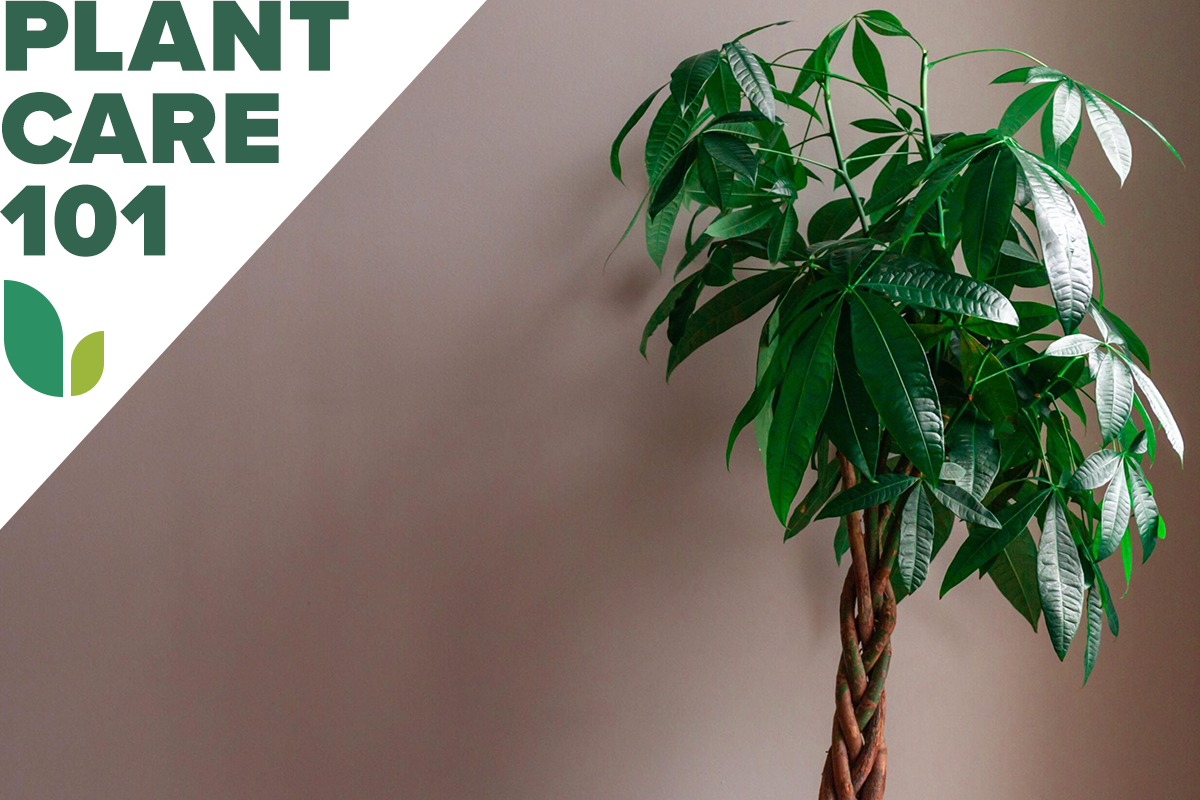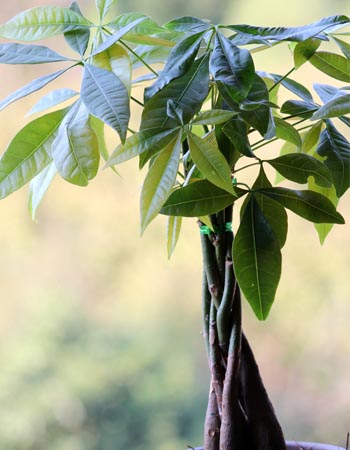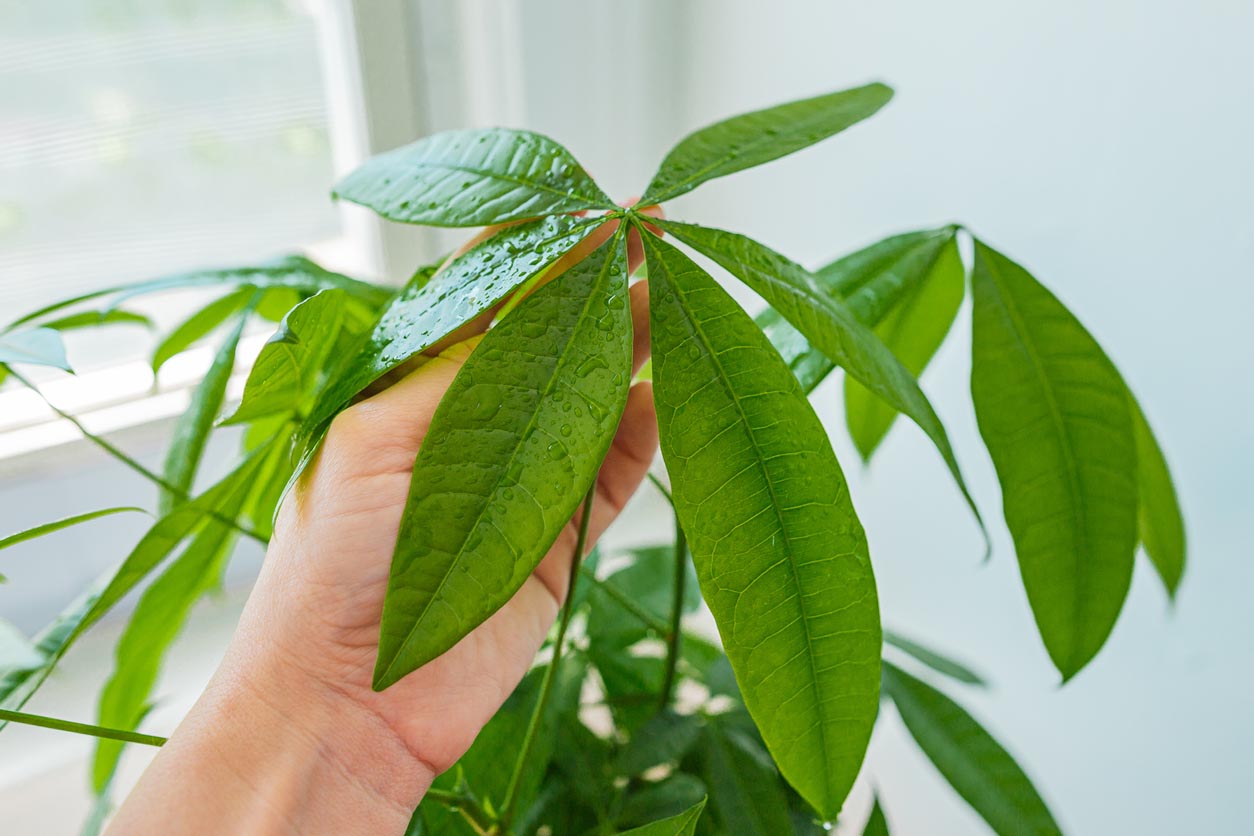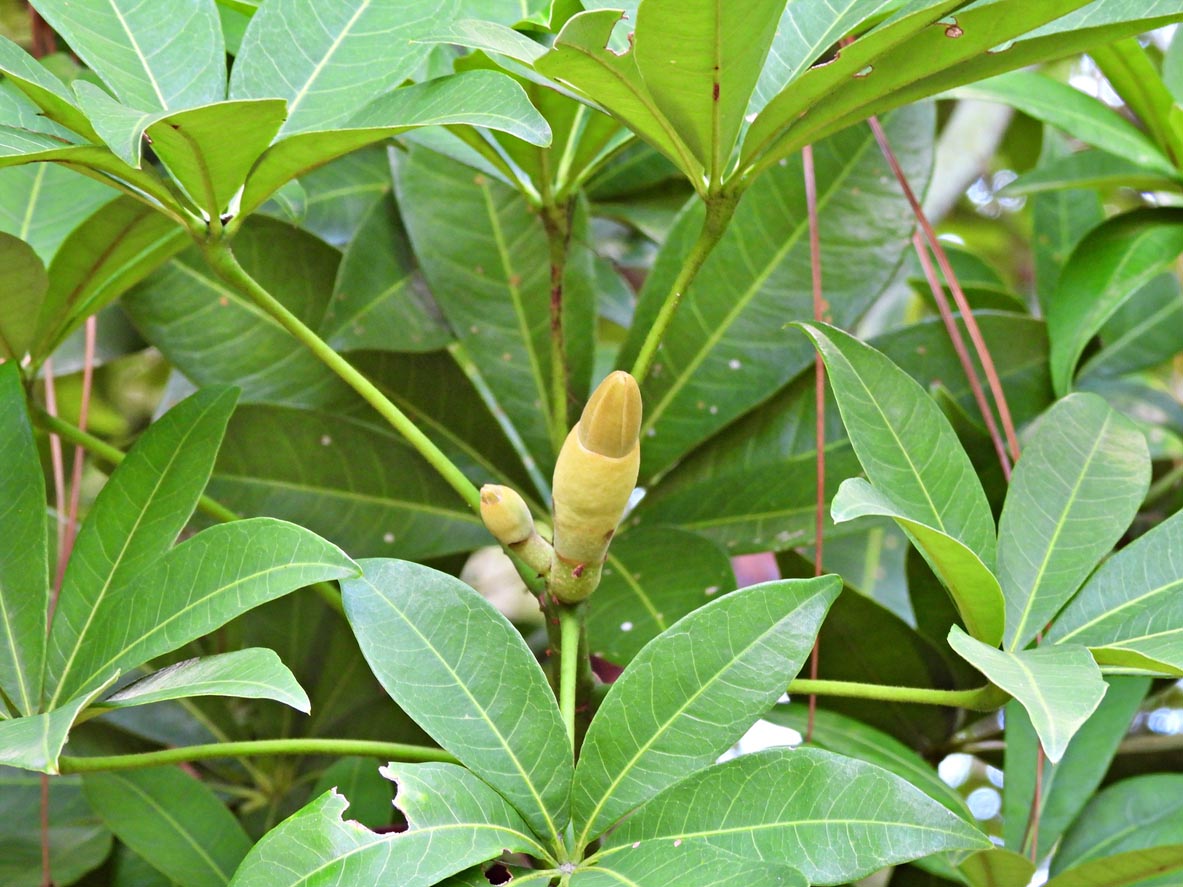

We may earn revenue from the products available on this page and participate in affiliate programs. Learn More ›
Popularized by feng shui practitioners who believe it will bring positivity and good fortune, the money plant is a surprisingly hardy tropical tree that can withstand a certain amount of neglect. It demands only some light and fairly consistent watering, which makes it a good plant choice for inexperienced growers.
First used as a houseplant in Taiwan in the 1980s—in part because it’s believed to create positive chi, or energy, in the home—the money tree makes a statement with its distinctive look. Imparting a tropical vibe to almost any interior space, the money tree plant typically features five trunks braided together, topped by bright green palmlike leaves. Not every plant this attractive is so easy to grow.
Money tree care isn’t especially difficult because the plant is forgiving. That said, there are some conditions that they find deleterious to their health. Once you learn how to take care of a money tree, you’ll be rewarded with the good fortune of flourishing fresh greenery in your home. The key to growing a money tree indoors is to provide the right amount of light, water, and humidity.
Money Tree Care At a Glance
Common Name: Money tree
Scientific Name: Pachira aquatica
Soil: well-draining with neutral to acidic pH
Light: bright, indirect light
Water: deep, only when the top 2 to 4 inches of soil feels dry
Food: twice yearly with houseplant fertilizer at half the recommended strength
Temperature and Humidity: at least 50 percent humidity; prefers temperatures between 60 and 80 degrees
Propagation: stem cuttings in soil or water
Safety: nontoxic to pets and humans
Money Tree Plant Characteristics

In addition to its scientific name—Pachira aquatica—the money tree goes by many other names: Guana chestnut, Malabar chestnut, saba nut, Bombax glabrum, monguba, and French peanut.
In its native habitat in Mexico and Central and South America, where it grows in marshy wetlands and bats can pollinate it, the money tree produces yellowish-white flowers that evolve into large seedpods containing peanut-like nuts. Outdoors, this majestic tree can reach 60 feet, but indoors, expectations range from 6 to 8 feet, although it also can be trained to grow as a bonsai.
Even though the money tree is plenty attractive as a houseplant, most people buy it because of its feng shui connection, hoping for the positive energy and good luck it’s rumored to bring. That legend derives from the fact that it grows five shiny, star-shaped leaves on each stem—five being an important number in feng shui, since it represents the five elements: water, wood, fire, earth, and metal.
More recent beliefs hold that the money tree can reduce stress and anxiety and relieve sleep disorders.
Selecting Soil for Money Plants
Money tree soil in a container should be moist but not wet, so a well-draining potting mix is suitable. To enhance drainage, you can add cactus soil, or some sand or gravel. But this plant also likes nutrient-rich soil, so a peat moss-based mixture also works. A pH-neutral or slightly acidic soil provides the best conditions for a money plant.
Typically, a money tree will require repotting about every 2 years. Choose a pot one or two sizes larger than it’s been in—and make sure the container has a drainage hole. If you don’t want your money tree to grow too fast, you can remove part of the root ball when repotting. Then place the plant back in the same container with fresh soil.
The Right Light
Although the money tree can tolerate direct sunlight when grown outdoors, the indoor-grown plants should receive bright to medium indirect light for at least 6 hours a day. Be sure to rotate the plant each time you water it so its growth is straight.
Ideally, place your potted money tree near a sunny window, but keep an eye on it; too much sunlight burns the leaves, turning them brown. Conversely, too little light results in yellowing leaves.
While it prefers bright natural light, the plant can adapt to artificial light given off by fluorescent or LED grow lights.

Watering Money Tree
Outdoors, money trees grow in areas that flood and near bodies of water, which probably explains the “aquatica” in its name. Although the plant likes water and it’s difficult to overwater a money tree, it is possible. Avoid leaving the pot in standing water, which can lead to root rot if the soil is too soggy. Overwatering or insufficient drainage can result in leaf drop and death. However, soil that is too dry, as well as low humidity, can lead to yellowing, browning, or drooping leaves that fall off.
Money tree watering is not complicated; only give it water when the top 2 to 4 inches of soil feels dry. Usually, the plants need more water during their growing season in the spring and summer. You can cut back on water in the fall and winter because the plants go dormant and don’t need water for growth.
Fertilizing Money Tree Plants
Any basic liquid houseplant fertilizer works well for a money tree, but it should be diluted to half the recommended strength. You can feed your money tree plant as seldom as once in early spring and once in midsummer, but a better plan is to feed it monthly throughout the growing season. In most climates, you can skip fertilizing in the winter.
For the ultimate money plant food, use compost tea. Compost tea bags soaked in water provide a controlled dose of nutrients for foliage development. This all-natural fertilizer also improves the soil by rebuilding its microbial populations for more nutrients.
Bonsai slow-release fertilizer can help with droopy, yellowing leaves. Jobe’s Houseplant Food Spikes (available on Amazon) provide essential nutrients such as nitrogen, potassium, and phosphorus and other trace minerals.
Related: 14 Symptoms of an Unhappy Houseplant (and How You Can Treat Them)
Setting the Temperature and Humidity
In its natural environment, the money tree grows in hardiness zones 10 and 11. As a tropical plant grown indoors, the money tree likes warm temperatures and lots of humidity. For best results, keep temperatures between 65 and 90 degrees. Avoid placing the houseplants near drafts, such as by exterior doors or heating and cooling vents.
Most indoor situations are significantly drier than the money tree’s natural home. Because the plants like around 50 percent humidity, it’s a good idea to increase the humidity around the plant by placing it on a pebble tray filled with water, setting a humidifier nearby, or misting the leaves regularly.

Propagating Money Tree Plants
Want to double your luck? Try propagating a money tree by taking stem cuttings in the spring or summer when the plant is growing. Using sterilized pruning shears or a sharp knife, cut a stem about 4 to 5 inches long with a few leaf nodes. Dip the cut end in rooting hormone (optional) and plant it in money tree-appropriate potting soil. Keep the cutting’s soil moist but not too wet for about a month, which is how long it usually takes new roots to form.
Another option is to place the cutting in water (skip the rooting hormone, if you opt for this propagation method). Wait for new roots to grow from the nodes, then pot the new money tree in its own planter.
Safety Considerations
The money tree is nontoxic to pets, according to the American Society for the Prevention of Cruelty to Animals (ASPCA). It’s also nontoxic to humans. In fact, the seeds can be roasted and consumed; they supposedly taste like peanuts (hence the plant’s nickname: the French peanut). In addition, the flowers and leaves can be cooked like vegetables for human consumption. Oil from the plant’s seeds even be used to make soap.
About the only creatures adversely affected by the plant are sand fleas. People have been known to disperse the seeds on the ground to repel the pests.

Related: The 22 Best Trees to Grow Indoors
Potential Pests and Diseases
The money tree plant is susceptible to common insects such as aphids and spider mites, which drain the plant’s moisture by sucking the sap out of it. In addition to those small bugs, mealybugs, scales, and whiteflies love the phloem sap from a money tree. The result is yellowing leaves. To eradicate these bugs, increase the humidity and use an insecticidal soap or neem oil.
Red spider mites suck the sap from the leaves, resulting in curled, discolored leaves that fall off. These creatures spread quickly and are easily detected by the tiny cobwebs. Isolate an infested plant and treat with insecticidal soap or neem oil. Increase the humidity to keep them from returning; the pests prefer dry conditions.
These plants are particularly susceptible to mealybugs and scale in indoor conditions. Treat infestations with mild insecticidal soap or neem oil. Fungus gnat babies eat the roots of money trees; the adults eat the fungus that has been growing in damp soil. The result is yellowing or wilting of the leaves. Be sure to let the soil dry out between waterings and check to ensure the pot is the right size and has adequate drainage to prevent insect infestations.
FAQs About Money Tree Care
Still have questions about how to care for a money tree? Here are answers to some common questions.
Q. How much sun does a money tree need?
Money trees require bright, indirect sunlight. Direct light can burn their leaves, but insufficient light results in poor growth.
Q. How do I take care of a money tree indoors?
Knowing how to care for a money tree indoors requires mimicking their native growing conditions: bright light, plenty of moisture, well-drained soil, and lots of humidity.
Q. Do money trees like to be misted?
Money trees love high humidity, so they will appreciate frequent misting.
Q. Where should I place my money tree indoors?
Place a money tree near a window where it will receive bright, indirect light. Once you find a spot that works, try not to move the plant. For feng shui, place it in the southeast corner of your office for financial prosperity or in an east window for health.
